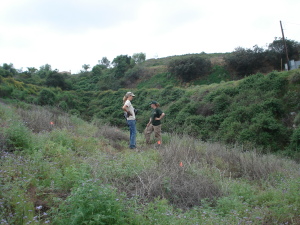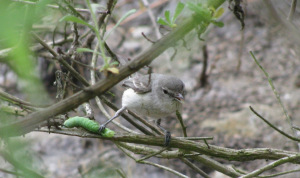
Area: 120 Acres
Location: Fullerton, Orange County, CA
Date Acquired: 2004-2005
Acquisition Type: CNLM holds a conservation easement as well as a long-term agreement to protect the imperiled species and their habitats on the preserve. The preserve is owned by third party.
Key Habitats: Coastal Scrub
Species of Special Interest to CNLM: Coastal California gnatcatcher (Polioptila californica californica), Least Bell’s vireo (Vireo bellii pusillus) and Cactus wren (Campylorhynchus brunneicapillus)
Introduction
The Coyote Hills East Preserve is located in the city of Fullerton—south of Bastanchury Road, west of State College Boulevard, and east of Brea Boulevard. This Preserve consists of 120 acres of coastal sage scrub, cactus scrub, and riparian woodland habitats, was established by Unocal to mitigate for development impacts to the federally threatened Coastal California gnatcatcher (Polioptila californica californica) and the Coastal cactus wren (Campylorhynchus brunneicapillus)—a species of special concern. Unocal operated an oil and gas field in the area and subdivided a portion of the property, selling the subdivided lots to a residential developer and the remainder of the land (including the Preserve and the golf course) to a private owner. The development plans for the new residential subdivision and golf course were specifically designed to provide protections for the gnatcatcher and the Coastal cactus wren by creating a habitat conservation area. In 2004-2005 CNLM was granted a conservation easement and long-term management agreement to protect the gnatcatcher and the Coastal cactus wren. The preserve and adjacent golf course continues to be owned by the private owner but is leased by American Golf Corporation, while the oil and gas fields are operated by Breitburn Energy Partners LP. The remaining preserve lands are owned by Chevron Land and Development Company (who acquired Unocal).
Conservation Significance
Prior to transferring the Preserve to the Center for Natural Lands Management (CNLM), Unocal restored the disturbed areas by replanting with coastal sage scrub species. This re-vegetation was very successful, as evidenced by the increase in Coastal California gnatcatchers from fewer than 10 pairs to more than 20 pairs in five years. Today, most of the Preserve is covered by dense coastal sage scrub habitat. Several patches of prickly pear cactus (Opuntia littoralis) scrub are interspersed with the coastal sage scrub, and a small creek runs through the golf course and Preserve. A well-developed riparian woodland composed of a mix of sycamore (Platanus racemosa), cottonwood (Populus fremontii), and willow species is present. This riparian habitat supports the federally endangered Least Bell’s vireo (Vireo bellii pusillus).
Our Work
Much of the coastal sage scrub at the Coyote Hills East Preserve is self-sustaining and requires little management assistance. Most of CNLM’s activities focus on controlling invasive exotic weeds, including pepper trees (Schinus molle), pampas grass (Cortaderia selloana), summer mustard (Hirschfeldia incana), and Italian thistle (Carduus tenuiflorus.). We also are removing brown-headed cowbirds (Molothrus ater) because they parasitize the nests of the Coastal California gnatcatcher and Least Bell’s vireo.
Public Access
Most of the Preserve is inaccessible to the public but can be viewed from various vantage points when golfing or using the trail through the city-owned Panorama Park. The trail is the best way to experience the Preserve because it passes over the highest point and has a scenic overlook.
For more information regarding the Coyote Hills East Preserve, click on the appropriate link below:
- Coyote Hills East Preserve Brochure (English)
- Coyote Hills East Preserve Brochure (Korean) Translation by: Ms. Ruthia Yi
Contact
For information about the Coyote Hills East Preserve or the Center for Natural Lands Management, please contact Korie Merrill, Preserve Manager at kmerrill@cnlm.org or 760.731.7790 extension 204.



